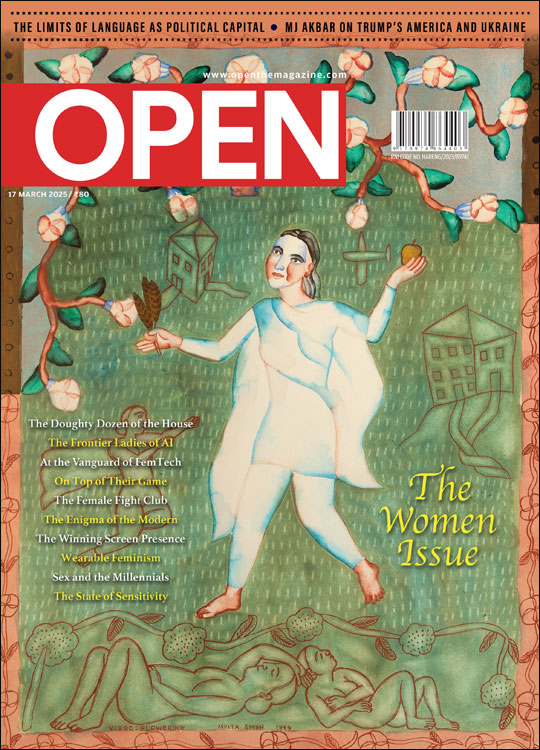The Crossdressing Raja and Rani of Jhansi
An extract from Mrinal Pandey’s translation of 1857: The Real Story of the Great Uprising by Vishnu Bhatt Godshe Versaikar. It is the only eyewitness account by an Indian of Rani Lakshmi Bai’s revolt
 Mrinal Pandey
Mrinal Pandey
 Mrinal Pandey
|
27 Jan, 2011
Mrinal Pandey
|
27 Jan, 2011
/wp-content/uploads/2015/11/jhansi2.jpg)
The only eyewitness account by an Indian of Rani Lakshmi Bai’s revolt
When we were planning the trip, many visions of Jhansi, based on the tales I had heard from Ram Kaka, swam through my mind. Jhansi is an ancient city, he had told us, with a total population of some fifteen lakh, and the fort at Jhansi is considered one of the strongest in the north. After the seat of the Peshwa at Pune disintegrated, Jhansi became an independent principality like Gwalior. Many of the rulers of Jhansi were childless. To continue the line, they usually adopted young boys as their heirs from within the clan as was customary among Hindus of high descent. Upon the demise of the ruler, his adopted son would ascend to the throne. The previous ruler of Jhansi, Gangadhar Rao, had also been childless, despite marrying twice. Because his request for adoption to the British Governor General in Calcutta remained unacknowledged till his death, his widow, Lakshmi Bai, took over. As the Rani of Jhansi, Gangadhar Rao’s widow adopted a young boy of some ten or eleven years, and since the British had still not agreed to her request for legalizing the adoption, the Rani herself handled the palace affairs.
Kaka had often spoken of Lakshmi Bai, the charismatic Rani of Jhansi, in connection with his own earlier association with her father, Rajshri Moro Pant Tambe, during his sojourn at Bithur. The royal yagnashala at Bithur was a vast place where many rituals were carried out regularly through the year, and also language and scripture classes were held for Brahmin students. Moro Pant had succeeded Kaka after he had chosen to return home to Versai. As the head priest of the Peshwa of Bithur, Moro Pant lived on the premises of the yagnashala with his motherless daughter Chhabili. The young Chhabili was a tall and slender girl, fair of face and well educated. She had an aquiline nose, a high forehead, and her eyes were large and shapely as the petals of a lotus. A bright and precocious child, she was loved by all and they addressed her as Chhabili, the pretty one.
Had she had a mother, the young Chhabili would probably not have been allowed out of the house at all and would have grown into a very different sort of young woman. But since there was no woman to take care of her at home, the little girl spent all her time at the yagnashala where her father sat all day. She ate, slept and played there while her father performed his duties and taught the scriptures to young boys from good families. Growing up thus, Chhabili developed a liking for boyish games and behaved like one. Her fellow students treated her as one of them and helped her learn not just reading, writing and account-keeping but also gave her lessons in fencing, archery and riding.
By the time Chhabili was eleven or twelve years old, her poor father had begun to fret about how to find her a suitable match from within his own community while he worked so far away from his native place…Moro Pant widened his search for a suitable boy for his only child to cover northern towns like Jalvan and Gulsarai in Hindustan where, because the rulers belonged to the south, a few families of southern Brahmins had come and settled. The Fates, however, wished for Chhabili to marry royalty—perhaps this is why, for a long time, her horoscope did not match those of suitable boys at any of these places. Poor Moro Pant was by now frantic with worry. He feared that if his liberally educated daughter was married off to some traditional Brahmin who begged for a living, she would never be appreciated for the fine qualities of her mind. A pearl like her needed the discerning eye of a jeweller.
Soon, his hopes were realized—but how! While Moro Pant was fretting over finding a suitable match for Chhabili, the ageing Brahmin ruler of Jhansi, Gangadhar Rao, who had lost his first wife, was also looking for a mature and pretty second wife from an appropriate southern Brahmin family. Unfortunately, the stars in Gangadhar Baba’s horoscope were rather unusually aligned and several strange tales about his eccentric behaviour also made parents of marriageable girls hesitate. It was rumoured that, every once in a while, Gangadhar Baba would start behaving like a woman. When the urge struck him, he would suddenly go to the roof of the palace, remove his male attire and return dressed as a woman in a resplendent zari choli and sari, with a colourful silken braid attached to his topknot, bangles on his wrists, pearls around his neck, a nose ring and jingling anklets. Thereafter, for a few days, he would shun the company of men entirely and sit and chat only with women. Apart from this, he would also observe four days of untouchability each month, as menstruating women do, and attend court only after he had performed the ritual cleansing bath on the fourth day. According to our scriptures, cross-dressing as a female is one of the eight evils a man must shun. So, even though he was royalty, no father in his right senses would have considered Gangadhar Baba a suitable groom for his daughter. It would be far better, some actually said when they were asked, to push your daughter down a dark well.
It seems that the British Resident had also heard some of these stories about Gangadhar Baba. One day, when he had gone to meet the Resident, Gordon Sahib, he said to Baba that he wished to ask him a personal question about a slightly awkward matter that had been bothering him for long. When Baba smiled and asked him to go ahead, Gordon Sahib said to him that Baba Sahib was a Brahmin with a very high lineage and an illustrious family background—why then would he continue to defy custom and dress as a female and even observe the four days of menstrual segregation? Did he like it, or was there some other reason for it?
Gangadhar Baba’s reply was that he was only the prince of a small region, but he felt that his fellow princes who ruled over far larger estates had been completely emasculated by rank outsiders from across the seven seas. It was a matter of collective shame for all native rulers that the British had managed to enter their land, made them subservient to them and, in a short while, were in a position to exact taxes from them. Since his own sense of helplessness and loss of independence had made him feel timid and inadequate like a woman, he occasionally chose to dress in female attire, with bangles on his wrists. The sahib left it at that and continued to act politely towards Baba, who, for his part, also maintained a certain transparency and dignity of demeanour in his dealings with the British right till the end of his days.
There could be no doubt, Moro Pant was told, regarding Gangadhar Baba’s masculinity because his first wife, who was religiously inclined, had borne him a son who had unfortunately died young. And all agreed that, even though there was something strange about him, he was a good ruler who hated sloth and upheld justice. He was very punctual and a hard taskmaster.
When his men brought news that a certain Moro Pant Tambe in the yagnashala of the Peshwas at Bithur had a good-looking daughter of marriageable age and seemed amenable to the match, Gangadhar Baba, who was desperate to get married and produce a son as soon as possible, immediately despatched a band of courtiers to begin the marriage negotiations. When the royal team from the Jhansi court came to Moro Pant’s house and formally asked for Chhabili’s hand in marriage for their ruler, the Brahmin expressed his delight…He told Gangadhar Baba’s men that the girl’s father would not ask the Jhansi royals to pay a bride price, but since he had no son or another offspring, and since this was a second marriage for Gangadhar Baba, he expected the bridegroom’s side to bear the overall expenses for the marriage and also provide Moro Pant with a suitable abode in Jhansi after the marriage was solemnized. The emissaries carried this message back to Gangadhar Baba and he agreed readily to Moro Pant’s demands. Thereafter…at an auspicious hour, Chhabili was married to Gangadhar Baba. She was now renamed Maharani Lakshmi Bai and, as the ruler’s father-in-law, Moro Pant Tambe came to be regarded as an eminent person in Jhansi. He himself now remarried and soon became a father to two children—a boy and a girl.
Lakshmi Bai’s was not a happy marriage. As a husband, Gangadhar Baba was a stern and suspicious man who allowed his wife very little freedom. Lakshmi Bai was confined within the walls of the palace and was mostly kept under lock and key, with her chambers guarded day and night by armed women. No male was allowed to enter her quarters. Under such exacting circumstances, the poor girl began to lose much of her earlier glow and, as a recluse, acquired a few strange habits.
Not too long after the marriage, the ageing Baba Sahib fell ill and passed away. As he lay dying, he sent for the British Resident, Gordon Sahib, and requested that since he was childless, as per custom, his young wife be permitted to formally adopt a boy from one of the families of his close relatives to succeed him. The Resident was very fond of Baba and tried hard to plead his case with the Governor General in Calcutta, but he was told that since there was no biological male heir, Jhansi must be merged with the British Empire and he, Gordon Sahib, should take charge as the chief administrator without losing any time. So Gordon Sahib finally carried out this task and became the Resident administrator in charge of the entire principality. Only a part of the Jhansi fort was left to the widowed Rani, along with the royal treasuries, which Gordon Sahib did not touch.
Life continued to go on as usual in Jhansi, with the Rani confined to her quarters within the fort and Gordon Sahib running the show. The Rani sent him a letter requesting his permission to go on pilgrimage to Kashi or Prayag, where she could formally be tonsured and begin the life of a traditional Brahmin widow. This request too was turned down. As expiation for her inability to go to Kashi, the Rani had to begin her day with a bath, smear her forehead with ashes and pay three Brahmins a rupee each before she could sit down to perform the daily rituals for the family deities.
Lakshmi Bai was an intelligent woman. She formally adopted a boy in keeping with her late husband’s wishes and then began a long correspondence with the British about getting the kingdom back. But by the month of May, the flames of the sepoy mutiny had begun to be visible in the north. This made the British stand rigid and the request of the Rani went unattended. Another matter regarding her pension also remained undecided for the same reason, even though the Resident had told her that he had forwarded all the necessary papers to England. Against this background of local royalty being repeatedly snubbed by the British, the news of unrest and defiance in the army camps at Meerut and elsewhere brought a change in the atmosphere in Jhansi almost overnight. Several British families that lived in the cantonment at Jhansi, along with the Resident and his wife, grew fearful, sensing the imminence of a popular uprising against the British. Finally, they were forced to appeal to the Rani for help.
On 9 June 1857, a day before the mutiny began, Gordon Sahib sent a message to the Rani that she should assume charge of Jhansi city and all the neighbouring areas that came under the principality. And that she should also now be in charge of its revenues, some twenty-five lakh rupees per annum. Till the trouble blew over, he told her, she would be the sole ruler and, as such, would also be expected to provide safety to the Resident and other members of his community by sharing her palace with them. However, she was told by an emissary of the British, that before the Rani could send them a formal letter, the British had assumed her compliance and were ready to move into her palace. This made the Rani livid. She let fly at the Resident’s emissary. She told him that she had not been invited to the Governor General’s big meeting in Calcutta along with other princes. Nor had the British respected Gangadhar Baba’s last wish to adopt a child as per the Hindu law. As a result, her husband had died a sad and worried man. After his death, when she herself wished to go on a pilgrimage, her request was turned down. Now that they feared for their own lives, the same Englishmen expected her to treat them with compassion and guard them and their families? Did they think that the native armies would accept this? If the soldiers got to know of their taking shelter in the fort, they would set it on fire.
…Later that night, the Resident himself came to the fort, unannounced and unaccompanied by his guards, to meet the Rani and repeated the request. He told the guards that he was there on an urgent business and must be allowed to meet her immediately. Lakshmi Bai came out when she was informed of this and, after the attendants withdrew, the two conversed quietly. The Resident told the Rani that his wife was seven months pregnant and in delicate health. The Rani must know by now, he said, about the dangerous state of affairs outside the fort and must help save his wife and her unborn child from harm. He said that he appealed to her as a woman and a regent, adding that they would be deeply indebted to her if she helped them out at this crucial time. The Rani heard him out and, being a noble soul, finally promised to protect the women and children of the British. Gordon Sahib went back and, at seven the next morning, the women and children from the British families came and took shelter under the Rani’s roof.
The mutiny was slated to start at ten o’clock that morning. And at exactly ten, the native soldiers went on a rampage. The few British men who had stayed on to guard the camp were killed and the army camp was then set on fire. After this, the soldiers arrived at the palace and told the Rani that she was their supreme leader now and they would only accept her commands henceforth. Lakshmi Bai told them to be ready for a bigger battle and had her drummers announce to the people that she was now in charge of Jhansi. After assuming charge of the day-to-day administration of the principality, she ordered the royal ammunition factories to work at a faster pace and increase production. She did not remove anyone from their jobs and restored the salaries that the British had curtailed. She also met Moro Pant daily; he saw to it that many yagnas for strengthening her power and destroying the enemies of Jhansi were performed throughout the city. The fort was repaired and its walls were strengthened…
The Rani was disciplined in her habits and followed an elaborate daily routine. She had been interested in daily exercise ever since she was a young girl. After the death of her husband and the end of the restrictions he had imposed on her, she resumed that regimen once again. She got up at the crack of dawn and began her morning with wrestling and weightlifting. She would then ride her horse. First, she would take it on a trot. Then she would run it faster, getting it to jump walls and leap over moats. Occasionally, she would ride an elephant as well. After a vigorous session at the gymnasium, she would go back to her quarters and break her fast. On some days, she would go back and rest after that; on others, after exercising, she would take a long, luxurious bath that she was said to like very much. Some fifteen to twenty pots of fragrant hot water were kept ready for her bath each day and the water that came out of the drains of her bath would suffice to bathe a dozen-odd women. After her bath, the Rani always put on a delicate white sari, especially woven for her in the town of Chanderi, which is renowned for its skilled weavers. She would then apply holy ash on her forehead (signalling the renunciation of worldly pleasures by a high-caste widow) and, having paid some money to three Brahmins, sit down in the prayer room to pray. When her husband died, since the British did not allow her to go to Prayag or Kashi, Lakshmi Bai had not tonsured her head. According to the scriptures, a widow who has not been tonsured must perform three acts of expiation each day before she begins her prayers. So the Rani began her day by offering holy water cupped in her palms thrice to the holy basil bush that stood in a special enclosure made of silver. Only after this would she worship Lord Shiva. At this point, the royal musicians would begin to sing hymns and the royal pandits would recite holy mantras from the scriptures. Thereafter, her courtiers would come and pay court to her. The Rani was very observant, and if even one out of almost a hundred and fifty courtiers missed attending this ritual for a day, she would ask him the next day where he had been.
By the time these interactions were over, it would be noon and the Rani would proceed for lunch. After a brief period of rest, she emerged again and silver platters filled with gifts presented to her by various people were brought to her for inspection. If she liked a particular item, she kept it with her and nodded. This indicated that the remaining articles were to be distributed to various people by the man in charge of the royal treasury. Around three in the afternoon, she held court. For this session, she sometimes appeared in male clothing: pyjamas, a waistcoat and headgear with a starched, fan-like top. Around her waist, she tied a scarf with gold embroidery and hung from it a sword in a scabbard. She was a tall, fair woman—dressed thus, she looked like an avatar of a warrior goddess. She would dress as a woman as well, but after her husband’s death, she had stopped wearing her nose ring and only wore gold bangles (not those made of glass or lac), a simple string of pearls around her neck and a diamond ring. As long as I was there, I saw no other ornament on her. Her hair was either tied in a large bun or hung below her waist in a long plait. She usually covered her head with a white shawl and sat against a bolster in a secluded little area under a golden arch of the durbar hall. The prime minister, Lakshman Rao, would stand in front of the Rani with official papers. Some seven or eight clerks sat on either side, taking notes. Lakshman Rao was a migrant Brahmin from the south who was not literate but extremely clever and shrewd. The queen was an intelligent woman and wasted no time in giving clear verdicts. Together, they dealt with all kinds of civil and criminal cases. Since Lakshmi Bai herself was well-educated, sometimes she wrote out the orders herself. She was an exemplary judge, clear-headed and merciless in dispensing justice. I occasionally saw her punish criminals herself with a stick. After the court was adjourned, the Rani visited the temple of Goddess Mahalakshmi in the company of her adopted son on Fridays and Tuesdays.
Alas, one will no longer be able to see the grand spectacle of the Rani riding out in public in her chariot or on horseback.
Her chariot was draped on both sides with heavy velvet curtains embroidered with gold thread. When she was dressed as a woman, she would wear a dazzling set of pearls with a white sari. Dressed in male attire, with her headgear and cummerbund, she appeared just as awe-inspiring and attractive. Two to four attractive unmarried young maidens ran alongside her chariot. These girls were trained since their childhood to run with the royal chariot. They were usually brought in from the south and fed well, so by the time they were fifteen or so, they were capable of running tirelessly with the royal mounts. They were all extremely beautiful, and if any of them were ever enticed by the young louts the town was full of and got with child, they were removed from the job and made to join the ranks of ordinary menials.
The maids who ran alongside the royal chariot wore ornaments made of gold and studded with precious stones. Their scarves were khaki or green in colour and the blouses they wore were embroidered with gold thread. They wore heavy anklets around their feet and red velvet shoes. When these lean beauties with waists like that of a she-tiger ran, carrying golden or silver parasols or fly whisks in one hand, holding on to the royal chariot with the other, the crowds were mesmerized by their beauty and the sheer energy they exuded. Male drummers, musicians playing martial tunes and flag-bearers led the royal procession. They were followed by some two hundred white soldiers. The royal chariot was flanked by riders both in front and at the back. The prime minister and other important people also rode alongside the Rani on horseback.
After the royal procession left the fort, the shehnai players who sat at the gates began to play their instruments and kept on playing till the Rani’s return. Shehnai was also played at the Mahalakshmi temple as the procession approached it. When the Rani rode on horseback, she was only accompanied by her courtiers and some white men. The maids and the staff-bearers were absent. Sometimes, when night fell, torches were lit to light up her path, but the Rani would often gallop into the fort in the dark, without torches.

/wp-content/uploads/2025/03/Cover-Women-Issue-2025.jpg)











More Columns
Is Trump Really Doing A 'Reverse Kissinger'? Sudeep Paul
Rohit Sharma And Toss Don't Go Well! Short Post
Bitcoin Mania Boost Madhavankutty Pillai